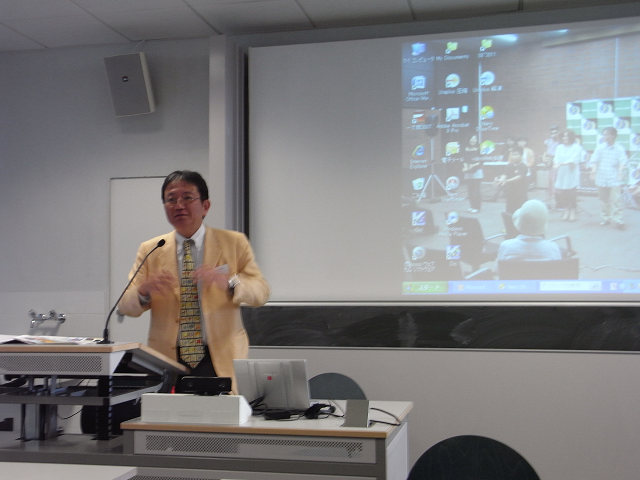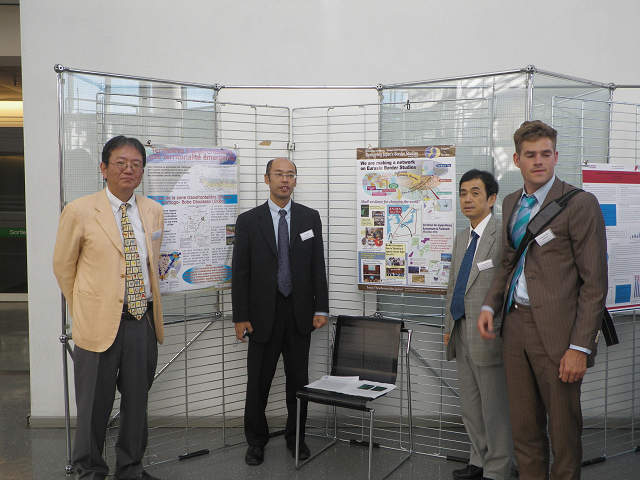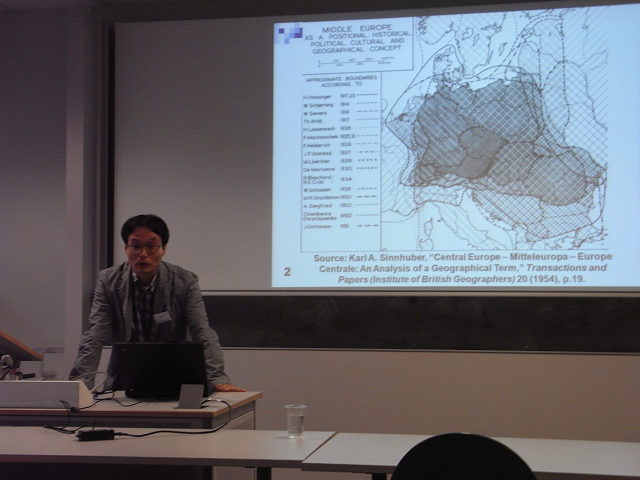
BRIT (Border Regions in Transition) Impressions, days 1 & 2
2011/09/09
The 11th BRIT Conference was held at the University of Geneva and the IGA (Institut de GĹśPographie Alpine) in Grenoble from September 6th-9th. On the first day of the Conference, the °»Sea cross-boundary cooperation of Japan and Korea across the Strait of Tsushima°… session saw  presentations by Messrs Nishijima (Fukuoka City), Kabu (Kyushu Economic Research Center) and Jung-Duk Lim (Emiritus Professor, Pusan University) on Japanese-Korean co-operation across the Tsushima Strait, before Iwashita Akihiro, head of the Slavic Research Center°«s GCOE program, showed the GCOE°«s newly-released Tsushima DVD and provided a multimedia presentation inviting the next BRIT Conference to East Asia for the first time.
presentations by Messrs Nishijima (Fukuoka City), Kabu (Kyushu Economic Research Center) and Jung-Duk Lim (Emiritus Professor, Pusan University) on Japanese-Korean co-operation across the Tsushima Strait, before Iwashita Akihiro, head of the Slavic Research Center°«s GCOE program, showed the GCOE°«s newly-released Tsushima DVD and provided a multimedia presentation inviting the next BRIT Conference to East Asia for the first time.

Additionally, an overview of the GCOE°«s activities was provided at the poster session.
On day 2, the °»Fluctuating Borders in Post- Soviet Countries°… session saw presentation' by two GCOE Researchers, Fujimori Shikichi and Fukuda Hiroshi. Fujimori°«s °»Border makes money? Unknown Business between the Unrecognized State and Neighbors°… talk dealt with economic issues in the breakaway region of Transnistria, while in his °»Central Europe as a Shifting Zone°… presentation, Fukuda spoke about concepts of Central Europe amongst intellectuals from the Habsburg to Inter-war periods, with both displaying an excellent grasp of their material. While the start of the session was delayed, the 20 or so experts on the former Soviet territories who attended engaged with the presentations, and continued to exchange views with the presenters even after the end of the session.
 In the °»The Edge of Eastern Eurasia: Mobile Borders between Russia and Japan?°… session that occurred simultaneously, four presentations were provided by Itani Hiroshi, Iwashita Akihiro, Tamura Masato and Paul Benjamin Richardson. Itani°«s focused on °∆Mobile Borders and Townscapes°«, looking at border and landscape changes seen from the city of Korsakov, facing the Soya Strait in Southern Sakhalin. In his °»Mobile Islands on the Border°…, Professor Iwashita spoke of the changes in Russo-Japanese border in the Kurils since the 1855 Treaty of Shimoda, the course of negotiations, and the separation in Territorial perceptions between the center and regions. Tamura°«s °»Mobile Border and Indigenous People°… highlighted the history of forced resettlement of the Ainu as a result of changes in the Russo-Japanese border on Sakhalin. Finally, in his °∆The Southern Kurils as a °∆Hyper-Border°«°«, Paul Richardson introduced his concept of the hyper-border, and emphasized its utility in examining the place of the °∆Northern Territories°«, the four disputed islands between Japan and Russia, in discursively analyzing their deployment by its inhabitants, by those concerned with the islands, and in the wider mass media. Despite the 08:30 start, attendance increased steadily to around thirty, who engaged in a lively discussion towards the end of the session.
In the °»The Edge of Eastern Eurasia: Mobile Borders between Russia and Japan?°… session that occurred simultaneously, four presentations were provided by Itani Hiroshi, Iwashita Akihiro, Tamura Masato and Paul Benjamin Richardson. Itani°«s focused on °∆Mobile Borders and Townscapes°«, looking at border and landscape changes seen from the city of Korsakov, facing the Soya Strait in Southern Sakhalin. In his °»Mobile Islands on the Border°…, Professor Iwashita spoke of the changes in Russo-Japanese border in the Kurils since the 1855 Treaty of Shimoda, the course of negotiations, and the separation in Territorial perceptions between the center and regions. Tamura°«s °»Mobile Border and Indigenous People°… highlighted the history of forced resettlement of the Ainu as a result of changes in the Russo-Japanese border on Sakhalin. Finally, in his °∆The Southern Kurils as a °∆Hyper-Border°«°«, Paul Richardson introduced his concept of the hyper-border, and emphasized its utility in examining the place of the °∆Northern Territories°«, the four disputed islands between Japan and Russia, in discursively analyzing their deployment by its inhabitants, by those concerned with the islands, and in the wider mass media. Despite the 08:30 start, attendance increased steadily to around thirty, who engaged in a lively discussion towards the end of the session.
 presentations by Messrs Nishijima (Fukuoka City), Kabu (Kyushu Economic Research Center) and Jung-Duk Lim (Emiritus Professor, Pusan University) on Japanese-Korean co-operation across the Tsushima Strait, before Iwashita Akihiro, head of the Slavic Research Center°«s GCOE program, showed the GCOE°«s newly-released Tsushima DVD and provided a multimedia presentation inviting the next BRIT Conference to East Asia for the first time.
presentations by Messrs Nishijima (Fukuoka City), Kabu (Kyushu Economic Research Center) and Jung-Duk Lim (Emiritus Professor, Pusan University) on Japanese-Korean co-operation across the Tsushima Strait, before Iwashita Akihiro, head of the Slavic Research Center°«s GCOE program, showed the GCOE°«s newly-released Tsushima DVD and provided a multimedia presentation inviting the next BRIT Conference to East Asia for the first time. 
Additionally, an overview of the GCOE°«s activities was provided at the poster session.
On day 2, the °»Fluctuating Borders in Post- Soviet Countries°… session saw presentation' by two GCOE Researchers, Fujimori Shikichi and Fukuda Hiroshi. Fujimori°«s °»Border makes money? Unknown Business between the Unrecognized State and Neighbors°… talk dealt with economic issues in the breakaway region of Transnistria, while in his °»Central Europe as a Shifting Zone°… presentation, Fukuda spoke about concepts of Central Europe amongst intellectuals from the Habsburg to Inter-war periods, with both displaying an excellent grasp of their material. While the start of the session was delayed, the 20 or so experts on the former Soviet territories who attended engaged with the presentations, and continued to exchange views with the presenters even after the end of the session.
 In the °»The Edge of Eastern Eurasia: Mobile Borders between Russia and Japan?°… session that occurred simultaneously, four presentations were provided by Itani Hiroshi, Iwashita Akihiro, Tamura Masato and Paul Benjamin Richardson. Itani°«s focused on °∆Mobile Borders and Townscapes°«, looking at border and landscape changes seen from the city of Korsakov, facing the Soya Strait in Southern Sakhalin. In his °»Mobile Islands on the Border°…, Professor Iwashita spoke of the changes in Russo-Japanese border in the Kurils since the 1855 Treaty of Shimoda, the course of negotiations, and the separation in Territorial perceptions between the center and regions. Tamura°«s °»Mobile Border and Indigenous People°… highlighted the history of forced resettlement of the Ainu as a result of changes in the Russo-Japanese border on Sakhalin. Finally, in his °∆The Southern Kurils as a °∆Hyper-Border°«°«, Paul Richardson introduced his concept of the hyper-border, and emphasized its utility in examining the place of the °∆Northern Territories°«, the four disputed islands between Japan and Russia, in discursively analyzing their deployment by its inhabitants, by those concerned with the islands, and in the wider mass media. Despite the 08:30 start, attendance increased steadily to around thirty, who engaged in a lively discussion towards the end of the session.
In the °»The Edge of Eastern Eurasia: Mobile Borders between Russia and Japan?°… session that occurred simultaneously, four presentations were provided by Itani Hiroshi, Iwashita Akihiro, Tamura Masato and Paul Benjamin Richardson. Itani°«s focused on °∆Mobile Borders and Townscapes°«, looking at border and landscape changes seen from the city of Korsakov, facing the Soya Strait in Southern Sakhalin. In his °»Mobile Islands on the Border°…, Professor Iwashita spoke of the changes in Russo-Japanese border in the Kurils since the 1855 Treaty of Shimoda, the course of negotiations, and the separation in Territorial perceptions between the center and regions. Tamura°«s °»Mobile Border and Indigenous People°… highlighted the history of forced resettlement of the Ainu as a result of changes in the Russo-Japanese border on Sakhalin. Finally, in his °∆The Southern Kurils as a °∆Hyper-Border°«°«, Paul Richardson introduced his concept of the hyper-border, and emphasized its utility in examining the place of the °∆Northern Territories°«, the four disputed islands between Japan and Russia, in discursively analyzing their deployment by its inhabitants, by those concerned with the islands, and in the wider mass media. Despite the 08:30 start, attendance increased steadily to around thirty, who engaged in a lively discussion towards the end of the session.





